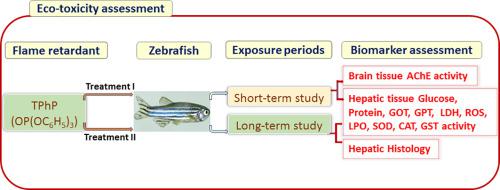Neurotoxicology and Teratology ( IF 2.6 ) Pub Date : 2020-08-24 , DOI: 10.1016/j.ntt.2020.106919 Mathan Ramesh 1 , Sajeev Angitha 1 , Satheesh Haritha 1 , Rama-Krishnan Poopal 2 , Zongming Ren 2 , Sathisaran Umamaheswari 1

|
Organophosphorus flame retardants (OPFRs) are high production volume (HPV) chemicals. Recent reports reveal that OPFRs are ubiquitous in the environment. Unfortunately, the toxicity profiles for OPFRs on organisms remain limited. Hence, to illustrate the potential toxic effects of OPFRs at environmental relevant concentrations on aquatic biota, in the present study, we investigated biochemical, enzymological, antioxidants, and histological (at long-term study) changes of zebrafish tissues under short- (96 h) and long- (21 days) -term triphenyl phosphate (TPhP) exposure. The hepatic glucose production (except short-term TPhP treatment up to 48 h), aspartate transaminase, alanine transaminase, lactate dehydrogenase, reactive oxygen species generation, lipid peroxide, and catalase activities were found to be increased in TPhP exposed groups when compared to control groups (normal and solvent control groups). The hepatic protein content and sodium dismutase activity were declined in TPhP exposed groups. Likewise, brain tissue acetylcholinesterase activity was declined in TPhP exposed groups. The hepatic glutathione S-transferase activity increased after 24 h under short-term TPhP exposure (96 h), while under long-term exposure period (21 days) the enzyme activity was accelerated when compared to control groups. Long-term TPhP exposure resulted in a series of morphological anomalies in the hepatic tissues of zebrafish. Our study reveals that TPhP can potentially cause antioxidants imbalance, alterations in enzymological and biochemical profiles, and morphological anomalies in hepatic tissues of zebrafish. Moreover, TPhP could cause neurotoxic effects on zebrafish at studied concentrations. Our findings expand the available toxicity profiles for TPhP on aquatic biota and propose that zebrafish are a good indicator, and studied parameters are valid biomarkers in assessing the eco-toxicological effects of OPFRs.
中文翻译:

有机磷阻燃剂对斑马鱼 (Danio rerio) 产生肝毒性和脑 AChE 抑制作用。
有机磷阻燃剂 (OPFR) 是高产量 (HPV) 化学品。最近的报告表明 OPFR 在环境中无处不在。不幸的是,OPFRs 对生物体的毒性特征仍然有限。因此,为了说明环境相关浓度的 OPFRs 对水生生物群的潜在毒性作用,在本研究中,我们调查了斑马鱼组织在短期(96 小时)下的生化、酶学、抗氧化剂和组织学(长期研究)变化。 ) 和长期 (21 天) 磷酸三苯酯 (TPhP) 暴露。肝葡萄糖产生(除了短期 TPhP 治疗长达 48 小时)、天冬氨酸转氨酶、丙氨酸转氨酶、乳酸脱氢酶、活性氧生成、脂质过氧化物、与对照组(正常和溶剂对照组)相比,TPhP 暴露组的过氧化氢酶活性增加。TPhP暴露组肝脏蛋白质含量和钠歧化酶活性下降。同样,TPhP 暴露组的脑组织乙酰胆碱酯酶活性下降。与对照组相比,在短期 TPhP 暴露(96 小时)下,肝谷胱甘肽 S-转移酶活性在 24 小时后增加,而在长期暴露期(21 天)下,酶活性加快。长期暴露于TPhP导致斑马鱼肝组织出现一系列形态异常。我们的研究表明,TPhP 可能导致抗氧化剂失衡、酶学和生化特征的改变以及斑马鱼肝组织的形态异常。此外,TPhP 在研究浓度下可能对斑马鱼造成神经毒性作用。我们的研究结果扩展了 TPhP 对水生生物群的可用毒性特征,并提出斑马鱼是一个很好的指标,研究的参数是评估 OPFR 生态毒理学效应的有效生物标志物。











































 京公网安备 11010802027423号
京公网安备 11010802027423号